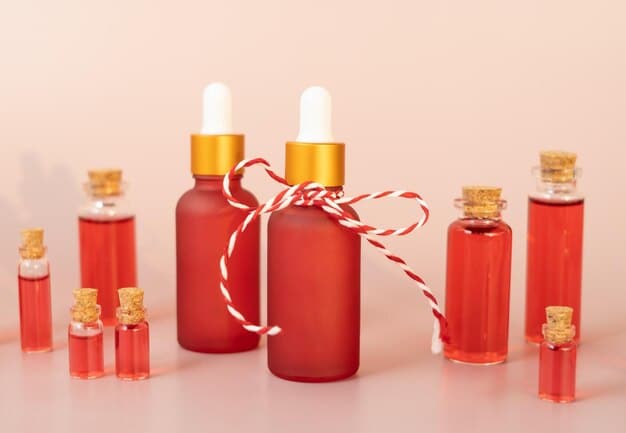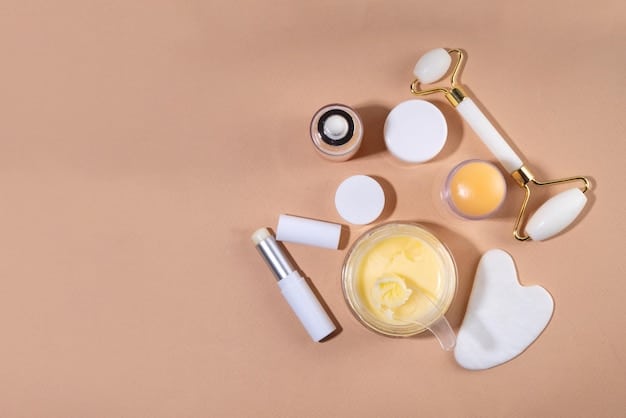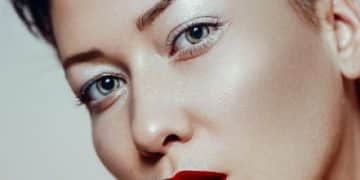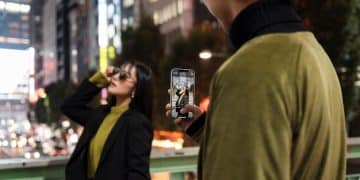K-Drama Beauty Trends in US: Top 3 Skincare Routines Unveiled

The surge in popularity of Korean dramas in the US has significantly influenced beauty standards, driving a remarkable rise in demand for K-beauty products and routines; specifically, this article explores the top three skincare regimens directly inspired by the flawless complexions seen on popular K-drama characters.
The global phenomenon of Korean dramas, or K-dramas, has captivated audiences beyond entertainment, reshaping cultural landscapes and, notably, influencing beauty trends worldwide. In the United States, this impact is particularly evident with The Rise of Korean Drama-Inspired Beauty Trends in the US: A Look at the Top 3 Skincare Routines. From glass skin to carefully sculpted brows, the flawless complexions and sophisticated styles seen on screen have spurred a significant interest in Korean beauty philosophies and products.
The K-Drama Effect on US Beauty Standards
Korean dramas have transcended their role as mere entertainment, becoming powerful cultural ambassadors. Their intricate plots, compelling characters, and stunning visuals—which often include protagonists with seemingly perfect skin—have created aspirational beauty standards that resonate deeply with viewers. This influence isn’t limited to what’s on screen; it extends to how American consumers perceive and approach their own beauty routines.
The meticulous, multi-step Korean skincare philosophy stands in stark contrast to the often simplified routines prevalent in Western beauty. K-dramas subtly showcase radiant, healthy skin as a cornerstone of beauty, inspiring viewers to explore the practices that achieve such luminescence. This shift is not just about adopting new products; it’s about embracing a more holistic and preventive approach to skin health.
From Screen to Skincare Shelf: How K-Dramas Drive Demand
The direct visual impact of K-dramas is undeniable. Characters often portray an idealized version of beauty, characterized by clear, hydrated, and youthful skin. This visual reinforcement acts as a potent marketing tool, making viewers curious about the “secrets” behind these complexions. As a result, there’s been an observable surge in the purchasing and adoption of K-beauty products and techniques in the US.
The narrative often intertwines with beauty, such as a character’s transformation linked to a newfound skincare regimen, further solidifying the connection in the viewer’s mind. This emotional investment fosters a desire to emulate the aesthetics, leading to a strong curiosity about authentic Korean beauty practices.
- Visual Aspiration: K-dramas showcase “glass skin” and healthy glows, setting new benchmarks.
- Character Emulation: Viewers aspire to achieve the clear complexions of their favorite characters.
- Product Curiosity: The allure prompts consumers to research and buy K-beauty products.
- Cultural Immersion: Skincare becomes a tangible way to connect with Korean culture.
Beyond individual scenes, the overall aesthetic of K-dramas, with their emphasis on natural beauty and subtle enhancements, aligns with a growing desire in the US for healthier, less-is-more beauty approaches. This trend is further amplified by social media, where K-drama fans share their favorite products and routines, creating a dynamic feedback loop that fuels continued interest and adoption.
The widespread accessibility of K-dramas through streaming platforms has democratized access to this cultural influence. What was once a niche interest has become mainstream, with beauty brands and retailers quick to capitalize on the rising demand for K-beauty products. This integration into the mainstream beauty discourse signifies a lasting shift, where K-drama aesthetics are no longer just a trend, but a significant force shaping global beauty standards, particularly in the US.
Understanding the Core Principles of K-Beauty Skincare
Before diving into specific routines, it’s crucial to grasp the foundational principles that underpin Korean beauty skincare. K-beauty is not just about using certain products; it’s a philosophy centered on prevention, consistency, and gentle yet effective care. It views skincare as an investment in long-term skin health, rather than a quick fix.
This holistic approach emphasizes layering lightweight products to deliver multiple benefits without overwhelming the skin. Hydration is paramount, as is protecting the skin barrier. The aim is to create skin that is not just superficially clear, but deeply healthy, resilient, and radiant from within. This distinction sets it apart from many Western approaches that often prioritize harsh treatments for immediate results.
The Philosophy of Layering and Prevention
At the heart of K-beauty is the concept of layering. Unlike applying one thick cream, K-beauty involves applying multiple thin layers of highly concentrated products, each designed to address a specific skin concern. This buildable approach allows for customization and ensures that the skin receives all the necessary nutrients without feeling heavy or suffocated.
Prevention is another cornerstone. Instead of waiting for issues like wrinkles or acne to appear, K-beauty routines meticulously focus on preventing them through consistent hydration, sun protection, and targeted treatments. This proactive stance contributes to the youthful, glowing complexions often seen in K-dramas, as problems are addressed before they become significant.
- Double Cleansing: The essential first step, removing oil-based impurities then water-based.
- Toner Application: Prepares skin for subsequent products, balancing pH.
- Essence Importance: A lightweight, highly concentrated hydrating step.
- Ampoules & Serums: Targeted treatments for specific concerns like brightening or anti-aging.
- Moisturization: Sealing in all the goodness with a hydrating cream or lotion.
- Sun Protection: Daily SPF is non-negotiable for preventing damage.
Moreover, the emphasis on gentle formulas and natural ingredients plays a significant role. Many K-beauty products are formulated with botanical extracts, fermented ingredients, and traditional herbs known for their skin-benefiting properties. This leans into a more natural and less irritating approach, which appeals to consumers seeking healthier alternatives to harsh chemical treatments.
Consistency is key in K-beauty. The numerous steps are not meant to be sporadic treatments but daily rituals. This dedication cultivates healthier skin over time, mirroring the commitment often displayed by K-drama characters in pursuing their goals. The principles of patience, discipline, and attention to detail are reflected both in the narratives and in the skincare practices they inspire, fostering a deeper connection between the audience and the beauty philosophy.
Top 3 K-Drama Inspired Skincare Routines for US Audiences
Inspired by the diverse needs and appearances showcased in K-dramas, three distinct skincare routines have gained significant traction among US audiences. These routines, while rooted in K-beauty principles, often cater to specific outcomes or address common skin concerns, making them highly adaptable for varied skin types and lifestyles. Each offers a nuanced approach to achieving that coveted K-drama glow.
These routines are not rigid prescriptions but rather flexible frameworks that can be customized with specific products. They represent a distillation of the most effective K-beauty techniques, designed to deliver visible improvements while maintaining the skin’s overall health and balance. The focus remains on hydration, nourishment, and creating a robust skin barrier, regardless of the ultimate aesthetic goal.
Routine 1: The “Everyday Radiance” for a Natural Glow
This routine is designed for those seeking a bright, healthy, and natural glow—the kind often seen on K-drama leads who project an effortlessly luminous appearance. It prioritizes hydration and basic nourishment, making it suitable for most skin types, especially those new to K-beauty.
- Morning:
- Gentle Cleanser: A mild, low-pH cleanser to refresh skin without stripping.
- Hydrating Toner: Pat an essence-like toner for immediate moisture.
- Light Serum: A vitamin C or hyaluronic acid serum for brightness and hydration.
- Moisturizer: A lightweight, non-comedogenic lotion or gel cream.
- SPF: Non-negotiable, a broad-spectrum SPF 30+ to protect against daily UV exposure.
- Evening:
- Double Cleanse: Start with an oil cleanser, follow with a water-based one.
- Hydrating Toner: Replenish moisture after cleansing.
- Sleep Mask (2-3x/week): Replace regular moisturizer with a hydrating sleep mask for an overnight boost.
- Eye Cream: A gentle, hydrating eye cream for delicate under-eye area.
This routine emphasizes consistency over complexity, ensuring the skin receives continuous hydration and protection. It’s about maintaining balance and fostering a healthy skin barrier, which naturally leads to a more radiant complexion. The products are generally gentle, minimizing the risk of irritation, and the steps are manageable for daily commitment, encouraging long-term adherence.

Routine 2: The “Glass Skin Goal” for Poreless Perfection
The “glass skin” trend, characterized by an intensely hydrated, smooth, and translucent complexion, has become iconic in K-beauty. This routine is for those willing to commit to more steps to achieve that almost impossibly flawless, poreless look, often reminiscent of porcelain dolls in historical K-dramas or sophisticated anti-heroines.
Achieving glass skin requires layered hydration and exfoliation to ensure extreme smoothness and light reflection. It involves more specialized products designed to refine skin texture and boost translucency. The focus here is on achieving an almost dewy, luminous finish that suggests exceptional skin health and care, providing that sought-after youthful sheen.
- Morning:
- Gentle Cleansing: A very mild, sometimes water-only, cleanse to preserve overnight goodness.
- Exfoliating Toner (2-3x/week): A gentle AHA/BHA toner for mild exfoliation.
- First Essence: A fermented essence for deep hydration and skin conditioning.
- Multiple Hydrating Serums: Layer hyaluronic acid, snail mucin, or ceramides for plumpness.
- Lightweight Moisturizer: Gel or emulsion to seal in moisture without heaviness.
- High SPF: A dewy finish SPF 50+ sunscreen for maximum protection and glow.
- Evening:
- Double Cleanse: Thorough oil and water-based cleansing.
- Exfoliating Toner (alternate nights): Focus on removing dead skin cells.
- First Essence, Hydrating Essence, and Ampoule: Layer these for intense moisture and targeting.
- Sheet Masks (3-4x/week): Infuse concentrated nutrients and hydration.
- Mid-weight Cream: A richer cream to lock everything in.
- Sleeping Mask: On non-sheet mask nights, apply a thicker sleeping mask.
This routine is an investment of time and product, but its proponents swear by its transformative power. It’s less about covering imperfections and more about cultivating skin so healthy and hydrated that it appears naturally poreless and radiant. The emphasis on layering ensures depth of hydration, which is critical for that luminous, translucent effect. The choice of products is often geared towards those that promote cellular turnover and maintain a plump, dewy look throughout the day.
Routine 3: The “Acne-Prone & Sensitive Skin” Sanctuary
Many K-dramas feature characters who overcome personal struggles, sometimes reflected in their physical appearance. This routine focuses on soothing and healing, inspired by the journey towards healthy, balanced skin. It’s tailored for those battling acne, redness, or general sensitivity, often seen in narratives where a character’s skin improves as they mature or find inner peace. The goal is calm, clear, and resilient skin.
This approach emphasizes gentle, non-irritating ingredients and avoiding anything that could trigger breakouts or inflammation. It’s about slowly nurturing the skin back to health rather than aggressively treating symptoms, aligning with a gentle, long-term healing philosophy.
- Morning:
- Low-pH Cleanser: A gentle, non-foaming cleanser to maintain skin barrier.
- Soothing Toner: Alcohol-free, with ingredients like centella asiatica or green tea.
- Lightweight Hydrating Serum: Hyaluronic acid or propolis serum for light moisture.
- Oil-Free Moisturizer: A gel or light emulsion to prevent clogging pores.
- Mineral Sunscreen: Zinc oxide or titanium dioxide SPF 30+ to avoid chemical irritation.
- Evening:
- Gentle Double Cleanse: An oil cleanser that emulsifies well, followed by a mild water-based cleanser.
- Soothing Toner: To calm and prepare the skin.
- Targeted Treatment (as needed): A spot treatment with tea tree oil or salicylic acid, applied sparingly.
- Barrier Repair Cream: A ceramides-rich cream to strengthen the skin barrier.
- Sleeping Pack (occasionally): A soothing sleeping pack for extra comfort and repair.
This routine is meticulous about ingredient selection, opting for anti-inflammatory and barrier-supporting components. It avoids common irritants and places a strong emphasis on reducing redness and promoting healing. By focusing on strengthening the skin’s natural defenses, this routine aims to achieve not
just clear, but comfortable and resilient skin, reflecting the restorative journey often seen in K-drama character arcs. The philosophy here is less about achieving “perfection” and more about attaining a state of enduring health and tranquility for the skin.

Beyond Products: Lifestyle & Cultural Influences
The K-drama inspired beauty trend is not solely about specific products or steps; it’s deeply entwined with broader lifestyle and cultural influences that contribute to overall well-being and, consequently, skin health. Understanding these intertwined elements provides a more holistic perspective on why these routines are so effective and appealing.
Korean culture places a significant emphasis on health, balance, and inner harmony, often reflected in daily habits. From diet to stress management, these factors play an undeniable role in how skin looks and feels. Embracing a K-drama inspired beauty philosophy often means adopting a more conscious approach to self-care that extends beyond the bathroom vanity.
Diet, Hydration, and Stress Management: The Korean Approach
In many K-dramas, food is often portrayed as nourishing and communal, rich in fermented ingredients and vegetables. This reflects a cultural emphasis on a balanced diet, which is widely recognized as having a direct impact on skin health. Ingredients like kimchi, soybeans, and ginseng, common in Korean cuisine, are not just culinary staples but are also valued for their potential skin benefits.
Similarly, hydration is not just about topical application; it’s about internal intake. Characters are often seen drinking water or healthy teas, reinforcing the idea of hydrating the body from the inside out. Stress management, though perhaps less explicitly depicted than diet, is also implicitly understood as crucial. Korean culture, with its focus on discipline and respect for wellbeing, encourages practices that reduce stress, knowing its detrimental effects on skin.
- Nutrient-Rich Diet: Emphasis on whole foods, fermented items, and vegetables.
- Ample Water Intake: Consistent internal hydration for skin elasticity.
- Herbal Teas: Incorporating traditional teas for their beneficial properties.
- Mindfulness Practices: Underlying cultural value on balance and reducing stress.
The concept of “well-being” is central to Korean beauty, suggesting that true radiance comes from a synergy of internal and external factors. This interconnectedness is often subtly woven into K-drama narratives, where characters’ journeys of self-discovery or healing are accompanied by positive changes in their self-care routines, leading to a more vibrant appearance. This deep understanding of holistic health makes the K-beauty approach more appealing than just a superficial application of products.
Furthermore, the idea of discipline and consistency, both in pursuit of life goals and in daily routines, is a recurring theme in K-dramas. This cultural value naturally extends to skincare, where consistent, gentle effort is seen as leading to lasting results. This patient, long-term perspective contrasts with the Western tendency for immediate gratification and quick fixes, offering a more sustainable path to skin health that resonates with increasingly health-conscious US consumers.
Challenges and Adaptations for US Consumers
While the allure of K-drama inspired skincare is strong, US consumers often face unique challenges in fully adopting these routines. Cultural differences, product accessibility, and varying environmental factors mean that a direct, one-to-one implementation might not always be feasible or even desirable. Adaptability becomes key for successful integration.
Recognizing these challenges and understanding how to adapt the core principles can help American users customize K-beauty routines effectively. It’s not about rigid adherence, but intelligent modification to suit individual needs, preferences, and available resources, ensuring the benefits can still be reaped without unnecessary obstacles.
Navigating Product Accessibility and Environmental Differences
One primary challenge for US consumers has historically been the accessibility of authentic Korean beauty products. While online retailers and certain brick-and-mortar stores have made significant strides, finding the full range of specific K-beauty brands and formulations can still be difficult, or require a higher financial investment due to import costs.
Beyond products, environmental differences play a role. The climate in various parts of the US can differ significantly from Korea. For instance, dry, arid regions might require richer moisturizers than those commonly used in humid Asian climates. Similarly, sun intensity can vary, necessitating different levels of SPF or reapplication frequencies. Understanding these nuances is crucial for effective adaptation.
- Product Availability: Researching reputable US-based K-beauty retailers.
- Climate Considerations: Adjusting product richness based on humidity and dryness.
- Water Hardness: Adapting cleansing methods if tap water is particularly hard.
- UV Index Variation: Tailoring SPF strength and reapplication frequency to local conditions.
Consumers also often have different lifestyle habits. A long, multi-step routine might not fit into every American’s busy schedule, requiring them to prioritize key steps or find multi-tasking products. The social and cultural context also means that while K-dramas inspire, the practical application often needs to be integrated into existing norms and routines.
Education is another hurdle. Understanding the purpose of each K-beauty step and ingredient can be overwhelming for newcomers. Many US consumers are accustomed to simpler routines and might be unfamiliar with terms like “essence” or “ampoule.” This gap in knowledge often necessitates extensive research or guidance to build an effective and sustainable routine, moving from simple curiosity to informed practice.
Future of K-Beauty Trends in the US
The trajectory of K-beauty in the US suggests more than just a fleeting trend; it points to a significant, lasting influence on the American beauty landscape. As K-dramas continue to gain viewership and as cultural exchange deepens, the integration becomes more profound, leading to innovations and further hybridization of beauty practices.
The future of K-beauty in the US will likely see a continued evolution, moving beyond mere product adoption to a deeper understanding and appreciation of Korean skincare philosophy. This will manifest in several key areas, from research and development to consumer education and market shifts, cementing its role in the global beauty industry.
Innovation, Hybridization, and Personalization
Expect to see continued innovation in K-beauty products themselves, with a focus on sustainable ingredients, advanced technologies, and formulations tailored for diverse skin concerns. Brands will likely respond to demand for more personalized solutions, moving away from one-size-fits-all routines towards more customizable product offerings. This could include AI-driven skin analysis or bespoke formulations.
A significant trend will be hybridization. US and Korean beauty philosophies will continue to merge, creating “fusion” products and routines that combine the best of both worlds. This might involve K-beauty’s emphasis on hydration and gentle care combined with Western preferences for potent active ingredients or streamlined routines. This blending creates exciting new possibilities for effective and efficient skincare.
- Ingredient Development: Focus on novel natural extracts and biotechnology.
- Smart Skincare: Integration of tech for personalized product recommendations.
- “Skipping Care”: Trend towards minimalist K-beauty for busy lifestyles.
- Sustainable Practices: Eco-friendly packaging and ethical sourcing.
Furthermore, the educational aspect will become more sophisticated. As consumers become more informed, there will be a greater demand for transparent ingredient lists, scientific backing for claims, and deeper understanding of product efficacy. This shift will push brands to provide more comprehensive information and foster a more educated consumer base.
Ultimately, the influence of K-dramas will continue to shape consumer perceptions of ideal skin and body care. The emphasis on healthy, luminous skin will persist, driving demand for products and routines that promise prevention and long-term radiance. This continuous inspiration will ensure that K-beauty remains a dynamic force, constantly adapting and evolving within the American market, fostering a global dialogue around beauty standards and practices.
| Key Aspect | Brief Description |
|---|---|
| 📺 K-Drama Influence | Dramas significantly shape US beauty ideals, popularizing K-beauty routines and products. |
| ✨ Core Principles | Emphasis on layering, prevention, gentle formulas, and a holistic approach to skin health. |
| 💧 Top 3 Routines | Everyday Radiance, Glass Skin Goal, and Acne/Sensitive Skin Sanctuary are leading trends. |
| 📈 Future Projections | Continued innovation, hybridization with Western beauty, and increased personalization are expected. |
Frequently Asked Questions About K-Drama Beauty Trends
▼
Glass skin refers to a complexion that is intensely hydrated, smooth, and so translucent it appears almost poreless, like a pane of glass. K-dramas significantly influence this trend by consistently showcasing characters with exceptionally clear and luminous skin, thereby setting an aspirational beauty standard that viewers often seek to emulate through specific K-beauty routines.
▼
Yes, K-beauty principles like gentle cleansing, hydration, and protection are universally beneficial. However, specific products and routine steps may need adaptation based on individual skin type, climate (e.g., dry vs. humid US regions), and specific concerns like acne or extreme sensitivity. Customization is key to achieving optimal results.
▼
K-beauty typically involves more steps, emphasizing layering of light products, prevention, and a holistic approach to skin health. Western routines often prioritize fewer steps, sometimes with harsher active ingredients, focusing more on immediate problem-solving rather than long-term skin barrier health. K-beauty aims for a dewy, hydrated look versus a matte finish.
▼
The double cleanse is considered fundamental in K-beauty because it thoroughly removes both oil-based impurities (makeup, sunscreen, sebum) with an oil cleanser, followed by water-based impurities (sweat, dirt) with a foaming or gel cleanser. This ensures a clean canvas for subsequent skincare steps, allowing products to penetrate more effectively. While not strictly “necessary” for everyone, it is highly recommended for best results.
▼
Authentic K-beauty products are increasingly available in the US through dedicated online retailers (e.g., YesStyle, Soko Glam, Stylevana), major beauty stores (e.g., Sephora, Ulta), and some Asian supermarkets. Always check reviews and retailer credibility to ensure product authenticity and quality. Direct shipping from Korean sites is also an option for wider selection.
Conclusion
The meteoric rise of Korean dramas in the US has not only reshaped entertainment consumption but has also fundamentally influenced beauty perceptions and practices. As we’ve explored, the flawless complexions seen on K-drama screens have inspired a genuine fascination with Korean skincare, translating into a tangible demand for its products and philosophies. The migration of K-beauty routines like “Everyday Radiance,” “Glass Skin,” and “Acne/Sensitive Skin Sanctuary” across the Pacific is a testament to their perceived efficacy and the growing desire among US consumers for healthy, glowing skin. This trend underscores a broader cultural exchange, where K-beauty’s emphasis on prevention, layering, and holistic well-being resonates deeply with a diverse American audience. It’s clear that the K-drama effect on beauty is more than just a passing fad; it’s a significant, evolving force that promises continued innovation and integration into the global beauty narrative, perpetually influencing how we approach self-care and strive for radiant complexions.





